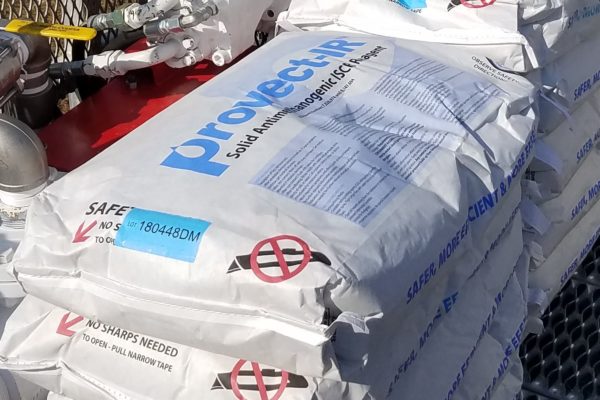Approach to Inhibit Methanogenesis during In Situ Sediment Treatment
MGP Conference 2015 | Providence, RI | April 15-17, 2015
By John Hull / John Collins (AquaBlok, LTD – Toledo, OH), Mike Scalzi (Innovative Environmental Technologies, Inc – Pipersville, PA) and Jim Mueller (Provectus Environmental Products, Inc. – Freeport, IL)
In situ sediment capping remediation systems at manufactured gas sites can mitigate the migration of contaminants through sediments. Two generalized approaches are possible: (1) passive capping, which is the deployment of a barrier material that is relatively impermeable to both the water above and the contaminants below; and (2) active/reactive capping, which employs one or more additives or amendments to a relatively permeable barrier in an effort to bind up and/or destroy the contaminants as they migrate through the treatment area. The choice of approach depends on a wide variety of site-specific issues, demands and conditions.
A common complication at many MGP sites is that the implementation/construction processes themselves typically create an initial spike of methanogenic activity because the sediment becomes disturbed and available carbon sources are more rapidly consumed. A second methane spike can occur later as oxygen is depleted from the remediated site, thus shifting the balance between aerobic biodegradation and anaerobic biodegradation in favor of the methanogenic anaerobes. The production of methane is problematic from several perspectives, including: i) stimulation of anaerobic microbial activity can lead to methylation of mercury and other heavy metals, with many negative consequences, and; ii) the production of methane can create gas bubbles (ebullition) which can transport contaminants via surface tension phenomena through localized cap failures due to gas buildup, and sometimes produce a toxic sheen at the water surface.
Research has demonstrated that certain statins specifically inhibit the growth and development of Archaea hence minimizing methanogenic activity (Scalzi and Karachalios, 2013). For example, statins have been administered to cows in an effort to manage rumen microbiology and reduce methane production. Provect-CH4™ is a proprietary amendment for environmental remediation applications that includes Red Yeast Rice (RYR) Extract. RYR extract contains a number of natural statin compounds, including Monacolin K (also known as Lovastatin), that effectively inhibit methanogens while permitting other biodegradation processes to occur.
This presentation will provide an overview of how Provect-CH4 methanogen inhibitors can be combined with AquaBlok®/AquaGate™ or Blended Barrier™/AquaGate™ to yield a composite particle containing an aggregate core that is layered with the reactive amendment materials and deployed through a water column over a contaminated site. The resulting permeable reactive cap will simultaneously treat contaminants while controlling methane production which manages several problems common to in situ sediment capping systems, including: i) reduced ebullition of gases that may breach the barrier cap; and ii) reduced methylation of heavy metals.
Contact:
Dr. James Mueller – Provectus Environmental Products, Inc., | Email: [email protected]

